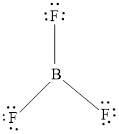
Concept explainers
(a)
Interpretation:
Molecular shape, bond angle and hybrid orbital of
Concept introduction:
Lewis structure is also called as Lewis dot structure. In this structure, valence electrons are represented by dot symbol around the central atom. This structure shows the bonding between molecule and the lone pairs which may occur in the molecule.
Answer to Problem 112A
Molecular shape of
Explanation of Solution
Valence electron of Cl is 7 and S is 6. Total number of valence electrons in

Central atom contains total 4 pair of electrons, two non bonding pairs and 2 bonding electron pairs. The molecular shape of
(b)
Interpretation:
Molecular shape, bond angle and hybrid orbital of
Concept introduction:
Lewis structure is also called as Lewis dot structure. In this structure, valence electrons are represented by dot symbol around the central atom. This structure shows the bonding between molecule and the lone pairs which may occur in the molecule.
Answer to Problem 112A
Molecular shape of
Explanation of Solution
Valence electron of both N is 5, Cl is 7 and H is 1. Total number of valance electrons in

Central atom contains total 4 pair of electrons, one non bonding pair and 3 bonding electron pairs. The molecular shape of
(c)
Interpretation:
Molecular shape, bond angle and hybrid orbital of
Concept introduction:
Lewis structure is also called as Lewis dot structure. In this structure, valence electrons are represented by dot symbol around the central atom. This structure shows the bonding between molecule and the lone pairs which may occur in the molecule.
Answer to Problem 112A
Molecular shape of
Explanation of Solution
Valence electron of both O is 6, F is 7 and H is 1. Total number of valence electrons in

Central atom contains total 4 pair of electrons, two non bonding pair and 2 bonding electron pairs. The molecular shape of
(d)
Interpretation:
Molecular shape, bond angle and hybrid orbital of
Concept introduction:
Lewis structure is also called as Lewis dot structure. In this structure, valence electrons are represented by dot symbol around the central atom. This structure shows the bonding between molecule and the lone pairs which may occur in the molecule.
Answer to Problem 112A
Molecular shape of
Explanation of Solution
Valance electron of B is 3 and F is 7. Hence, total number of valance electron is

Central atom contains total 3 bonding electron pairs. The molecular shape of
Chapter 8 Solutions
Chemistry: Matter and Change
Additional Science Textbook Solutions
Chemistry: A Molecular Approach (4th Edition)
Biology: Life on Earth (11th Edition)
Campbell Biology in Focus (2nd Edition)
Campbell Essential Biology (7th Edition)
Chemistry: Structure and Properties (2nd Edition)
Introductory Chemistry (6th Edition)
- (a) Sketch the 'H NMR of the following chemical including the approximate chemical shifts, the multiplicity (splitting) of all signals and the integration (b) How many signals would you expect in the 13C NMR? CH3arrow_forwardDraw the Show the major and minor product(s) for the following reaction mechanisms for both reactions and show all resonance structures for any Explain why the major product is favoured? intermediates H-Brarrow_forwardChoose the right answerarrow_forward
- 8. What is the major product of the following reaction? KMnO4 b a TOH OH OH C d OH "OH HO OH OHarrow_forwardChoose the right answerarrow_forward3. Draw ALL THE POSSBILE PRODUCTS AND THE MECHANISMS WITH ALL RESONANCE STRUCTURES. Explain using the resonance structures why the major product(s) are formed over the minor product(s). H₂SO4, HONO CHarrow_forward
- 7. Provide the product(s), starting material(s) and/or condition(s) required for the No mechanisms required. below reaction HO + H-I CI FO Br2, FeBr3 O I-Oarrow_forward6. Design the most efficient synthesis of the following product starting from phenot Provide the reaction conditions for each step (more than one step is required) and explain the selectivity of each reaction. NO MECHANISMS ARE REQUIRED. OH step(s) CIarrow_forwardWhat is the skeletal structure of the product of the following organic reaction?arrow_forward
- If a reaction occurs, what would be the major products? Please include a detailed explanation as well as a drawing showing how the reaction occurs and what the final product is.arrow_forwardWhat is the major organic product of the following nucleophilic acyl substitution reaction of an acid chloride below?arrow_forwardWould the following organic synthesis occur in one step? Add any missing products, required catalysts, inorganic reagents, and other important conditions. Please include a detailed explanation and drawings showing how the reaction may occur in one step.arrow_forward
 ChemistryChemistryISBN:9781305957404Author:Steven S. Zumdahl, Susan A. Zumdahl, Donald J. DeCostePublisher:Cengage Learning
ChemistryChemistryISBN:9781305957404Author:Steven S. Zumdahl, Susan A. Zumdahl, Donald J. DeCostePublisher:Cengage Learning ChemistryChemistryISBN:9781259911156Author:Raymond Chang Dr., Jason Overby ProfessorPublisher:McGraw-Hill Education
ChemistryChemistryISBN:9781259911156Author:Raymond Chang Dr., Jason Overby ProfessorPublisher:McGraw-Hill Education Principles of Instrumental AnalysisChemistryISBN:9781305577213Author:Douglas A. Skoog, F. James Holler, Stanley R. CrouchPublisher:Cengage Learning
Principles of Instrumental AnalysisChemistryISBN:9781305577213Author:Douglas A. Skoog, F. James Holler, Stanley R. CrouchPublisher:Cengage Learning Organic ChemistryChemistryISBN:9780078021558Author:Janice Gorzynski Smith Dr.Publisher:McGraw-Hill Education
Organic ChemistryChemistryISBN:9780078021558Author:Janice Gorzynski Smith Dr.Publisher:McGraw-Hill Education Chemistry: Principles and ReactionsChemistryISBN:9781305079373Author:William L. Masterton, Cecile N. HurleyPublisher:Cengage Learning
Chemistry: Principles and ReactionsChemistryISBN:9781305079373Author:William L. Masterton, Cecile N. HurleyPublisher:Cengage Learning Elementary Principles of Chemical Processes, Bind...ChemistryISBN:9781118431221Author:Richard M. Felder, Ronald W. Rousseau, Lisa G. BullardPublisher:WILEY
Elementary Principles of Chemical Processes, Bind...ChemistryISBN:9781118431221Author:Richard M. Felder, Ronald W. Rousseau, Lisa G. BullardPublisher:WILEY





